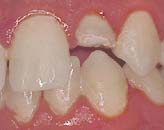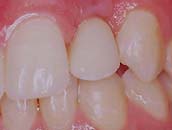Injury to Permanent Teeth
“Unlike bone fractures, fractures of the crowns of teeth do not heal or repair. problems may develop later due to damage to the pulp.” – U.S. Surgeon General’s Report
- What are the common causes of tooth damage?
- What can be done if a tooth has been damaged?
- Can injured teeth crack?
- What can be done if a tooth has fractured below the gum line?
- What can be done if a tooth has been knocked loose?
- What can be done if a tooth has been knocked out of position?
- Can a tooth that has been knocked out of the mouth be saved?
- What is the prognosis for re-implanted teeth?
- Is there any way of protecting teeth from sports injuries?
1. What are the common causes of tooth damage?
- The leading causes of oral injuries are sports, violence, falls and motor vehicle collisions.
- Bad eating habits such as biting down strongly on a hard sucking sweet, a bone, or any solid object, are often the causes of damage to teeth.
- After any injury to a tooth, a visit to the dentist is necessary, with follow up visits to monitor the recovery.
Return to Questions
2. What can be done if a tooth has been damaged?
- Varying degrees of damage can occur, from mild chipping through to fracture, and to loss of the tooth. The treatment will vary:
- If the enamel is chipped, smoothing the sharp or roughened edge is usually all that is needed.
- If a front tooth has a chipped biting edge, a tooth-coloured plastic filling can be bonded to the tooth.
- This will restore the tooth’s shape and appearance, and protect the edge from further damage.
- Since the enamel has no nerve supply, all the above treatments are painless.
- If the crown of a tooth has a larger piece broken off, it is likely to cause the dentine to become sensitive to hot and cold.
- This can be repaired with a tooth coloured filling, or the fitting of a veneer restoration.
- Impact Injuries from sports accidents or assaults often affect the front teeth, as they are most vulnerable.

Before |
|

After |
- A major break of the crown can expose the nerve and blood vessels.
- This can cause severe pain, and infection is likely to follow.
- A root canal treatment will be required before the crown of the tooth can be repaired.
- Extensive damage usually requires a veneer or replacement crown restoration.
- This will restore the appearance of the tooth, and will cover the exposed, sensitive tooth surface.

Before |
|

Root canal treatment |
|

After replacement crown |
Return to Questions
3. Can injured teeth crack?
- Injured teeth can crack, causing craze lines in the enamel of the crown of the tooth.
These do not usually cause any pain.
If they become stained, they may spoil the appearance of the tooth.
- Cracks can affect the nerve tissue within the tooth. This is a more serious condition.
- The teeth will then be sensitive to temperature changes and biting pressure.
- Pain is felt on chewing.
- This is called the cracked tooth syndrome.
- A root canal treatment followed by a replacement crown, is the likely treatment.
Return to Questions
4. What can be done if a tooth has fractured below the gum line?
- When the break occurs below the gum line, the tooth may have to be exposed by surgery.
- This has to be done to enable the dentist to work on the root.
- A root canal treatment has to be done, and a replacement crown fitted.
- This is called a crown lengthening procedure.

Before |
|

After crown fitted |
- Sometimes the fracture line is far below the gum line.
- The root must then be moved to a position above the gum line before treatment can be continued.
- Orthodontic braces are used for this purpose.
- The treatment includes root canal treatment, crown lengthening and a replacment crown.
- If the fracture is too severe, the tooth may have to be extracted.

1) Before |
|

2) Surgery |
|

3) Core preparation |
|

4) Final crown |
Return to Questions
5. What can be done if a tooth has been knocked loose?
- The dentist will check the damage to the tooth, by taking an X-ray.
- Treatment will be dependent on the severity of the injury:
- The loose tooth can be kept in position by joining it to a firm tooth next to it. The loose tooth must be held firmly in place to allow healing of the bone around the tooth. This is referred to as using a splint.
- The example shown below demonstrates how a mesh is bonded to the teeth to hold them in place.
- Regular testing for a response to hot and cold stimulation will indicate the health or vitality of the tooth.
- If the tooth discolours, it is a sign that the nerve and blood vessels within the tooth have died.
- A root canal treatment will then be necessary.

Splint for loose teeth |
Return to Questions
6. What can be done if a tooth has been knocked out of position?
- If after injury, the tooth has been partially moved out of position, the dentist may be able to reposition it with finger pressure.
- Stabilising the tooth by attaching it to adjacent teeth on either side will then be needed.
- This procedure is called splinting.
- The dentist will monitor the progress of the tooth over a period of time.
Return to Questions
7. Can a tooth that has been knocked out of the mouth be saved?
Avulsion refers to a tooth being knocked out of the mouth.
- Treatment at the scene of the accident:
- Successful re-implantation of a tooth that has been knocked out of the mouth depends on how quickly the tooth can be replaced in its socket.
- The tooth should be cleaned in saliva, saline, or milk, and replaced into the socket.
- If the tooth can be placed back into the socket, hold it there and see the nearest dentist immediately.
- If it cannot be replaced, place it in milk and get to the dentist as soon as possible.
- Immediate dental treatment:
- The dentist will re-implant the tooth and hold it in position for about 20 minutes.
- The dentist will then splint the tooth to the adjacent firm teeth, by using a bonding material.
- An antibiotic, a mouthwash, and pain relief will be prescribed.
- A tetanus booster injection may be advisable.
- Follow up treatment:
- Follow up treatment will require a root canal treatment, as the nerve and blood vessels within the tooth have been severed at the apex of the root.
- The splint will be removed after the tooth has become firm again.
Return to Questions
8. What is the prognosis for re-implanted teeth?
- Most re-implanted teeth last for at least 5 years.
- Over time the root of the re-implanted tooth may undergo resorbtion.
This is not uncommon as the health of the area around the root has been impaired.
Return to Questions
9. Is there any way of protecting teeth from a sports injury?
- Soft mouthguards are designed to protect the teeth, gums and jaws.
- They should always be worn when teeth are at risk from injury.
- Mouthguards are available off the shelf at sports shops and drug stores (pharmacies).
- It is preferable to have a professional mouthguard made by your dentist.
- It will have a better fit and be less bulky.
- The incidence of sports injuries to teeth is relatively high, and it is advisable to take precautions.
Front teeth are particularly vulnerable to impact injuries in contact sports such as rugby, football, hockey and boxing.

Regular mouthguard |
|

Professional mouthguard |
|

Mouthguard in place |
See Mouthguards
Return to Questions
Copyright © 2012 of Simplyteeth – All rights reserved.
The material contained in Simplyteeth.com is offered as information only, see our full legal disclaimer.
This website has been invisibly watermarked to protect the copyright.
Site Map














